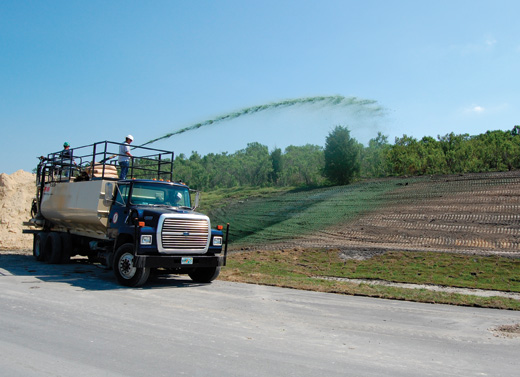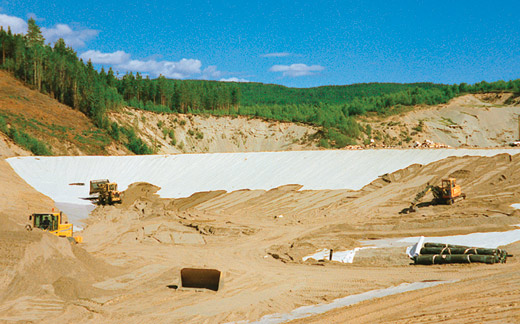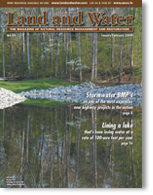Features Available Online
Legacy Planning
For the mining boom to be meaningful, reclamation must be part of the plan.
by Chris Kelsey

Erosion control is a vital part of reclamation. After proper barrier and drainage layers have been installed, the quick establishment of vegetation goes a long way toward real recovery for a site. Blankets, turf reinforcement mats (TRMs) and hydroseeding products are frequently used. Photo credit: North American Green.
The mining of precious and semi-precious metals, minerals and fossil fuel energy sources such as coal has long been a mixed blessing for the communities in which operations take place. Mining can offer a great deal of employment, especially in rural areas in need of industry, and significant and welcomed tax revenue.
But the long-term environmental harm of mining has too often off-set, if not overwhelmed, the benefits to these communities.
Clean-up costs are tremendous.
For example, the Gilt Edge Mine Superfund site near Deadwood, South Dakota is in need of millions of dollars of support. When its owner, Brohm Mining Co., filed for bankruptcy in 1999, it left behind 150 million gallons of acidic and metal-contaminated water in the open pits. It also left behind millions of cubic yards of acid waste rock. The United States Environmental Protection Agency (US EPA) has since been working on temporary relief measures with the South Dakota Department of Environment and Natural Resources. The EPA released its proposed long-term cleanup plan in late May 2008.
Gilt Edge is just one of many examples of how mining goes awry.
Clearly, we cannot do without mining. That would be a rather ridiculous argument. Gold is certainly more than just jewelry or a financial trade. It’s also key to corrosive-free conductors within electronics and computers. It’s used in cancer treatments and in aerospace design. It’s used in many industries, as are other mined materials.
But we can mine with greater safety and with better long-term controls. Geosynthetics offer that support in both active operations and post-closure reclamation.
RIGHT HERE, RIGHT NOW
The polymeric nature of geosynthetics enables all of this potential. They are highly engineered for specific purposes. Their particular resin formulations give them properties such as chemical and puncture resistance.
The past few decades have seen considerable advances in material construction technology. Geosynthetics have been part of this advance, as the materials emerged in the 1980s from decades of research and experimentation into common practice.
The long-term performance data from early installations has been incredibly supportive.

Geosynthetic clay liners (GCLs) and geomembranes are the major containment materials used in active mines and for remediation. Post-closure, it is often vital to prevent rainwater incursion. Clay and soil-only caps are seldom appropriate. Geosynthetics provide the proper barrier. Photo credit: NAUE GmbH Co. KG and NAUE America.
As such, we’re now seeing geosynthetic materials at both ends of mining development: for initial environmental controls and for safe closure, such as for capping old heap leach zones so that clean soil may be deposited on top.
But geosynthetics are not just used in the environmental control aspects of mining, such as to line tailings ponds. They are used to create stronger access roads (geogrid reinforcement, geotextile separators in subgrade), in industrial process and recovery facilities (geomembrane liners), drainage control (geocomposites), erosion control (turf reinforcement mats, etc.)
This is key to long-term site health. The more control we have now, the less we need to do later.
For sites that were mined before the wider-scale adoption of geosynthetics, the materials are providing excellent corrective containment options so that sites may begin to heal. The installation of geomembranes and geosynthetic clay liners (GCLs) over contaminated soil can allow for redevelopment.
At the very least, they seal off the polluted zones so that contaminated soils are not blowing freely or washed out by rainwater.
RECLAMATION NEED WILL GROW
The current boom in mining suggests a great deal of reclamation work will be needed around the world. Precious and semi-precious metal prices have risen so substantially that sites once thought too difficult to mine profitably are now being put into operation.
This is especially true in industrialized countries where strict environmental controls add to costs.
Australia forecasts a 70% rise in its mining employment through 2020—which means 90,000 new jobs will be created. Canada estimates that 92,000 jobs will be created in its mining industry through 2017, many of them in engineering. In the United States, the old Iron Range of Minnesota is now the subject of copper and nickel mining debates. Industry and lawmakers want the developments, but the environmental costs are worrisome.
Consider that the more difficult a site is to mine, the more likely it is that severe methods of extraction will have to be used.
For an example, consider nickel mining. Nickel comes in two types: laterites and sulphides. The latter is deeper in the earth but easier to process. The former is the dominant sort in today’s mining, but not by choice. It is simply the lionshare of accessible deposits right now. Laterite mining is near the surface, but the nickel requires acid leaching and high temperatures. The likelihood of future contamination is higher.
Geosynthetic materials will be there for final closure operations.
BE CERTAIN
In many areas, investment requirements are now being instituted to ensure that mining site owners cannot declare bankruptcy in order to avoid cleaning up their operations. Many new developments must demonstrate that they have established a fund into which closure costs are being placed during the mine’s primary life of profit.
But cleanup will almost certainly be necessary to some degree due to the severity of chemicals used in mining and the considerable stripping of land that occurs.
It is crucial to choose your geosynthetic materials properly. One hopes specifications include checks to guarantee expert handling, but that isn’t always the case. Seek out expert help to review your plans and provide construction quality assurance (CQA).
Failure to understand which materials are qualified to contain the types of contamination a site presents can lead to serious failures of liners, caps, drainage channels, and much more.
What follows is a list of companies that provide key barrier and erosion control materials used commonly in mine reclamation operations. This list is only a partial list of their reclamation offerings and of all possible providers. Their websites and personnel may be consulted for more detailed information regarding the suitability of materials for your site’s immediate and long-term needs.
American Excelsior – erosion control products
www.curlex.com
Agru America – geomembranes
www.agruamerica.com
Atarfil – geomembranes
www.atarfil.com
BTL – geomembranes
www.BTLLiners.com
CETCO – geosynthetic clay liners, geomembranes, drainage products
www.cetco.com/LT
Checkmate – erosion control and containment materials
www.checkmategeogrids.com
Colbond – erosion control and drainge materials
www.colbond-geosynthetics.com
Cooley – geomembranes
www.cooleygroup.com
East Coast Erosion Blankets – erosion control
www.erosionblankets.com
Erosion Control Blanket – erosion control
www.erosioncontrolblanket.com
Fiberweb – erosion control and drainage materials
www.fiberweb.com
Firestone – geomembranes
www.firestonesp.com
FLI – geosynthetic installation
www.fli.ie
GSE – geomembranes, geosynthetic clay liners and drainage materials
www.gseworld.com
I-CORP INTERNATIONAL – design and liner integrity testing CQA
www.geosynthetic.com
Maccaferri – erosion control and drainage materials
www.maccaferri-usa.com
NAUE – geomembranes, geosynthetic clay liners, drainage and erosion control
www.naue.com
North American Green – erosion control
www.nagreen.com
Permathene – erosion control and drainage materials
www.permathene.com
Propex – erosion control and drainage materials
www.geotextile.com
Raven – geomembranes
www.ravenind.com
Renolit AG – geomembranes
www.alkorgeo.com
Sensor – leak location CQA
www.sensor.sk
Solmax – geomembranes
www.solmax.com
Sotrafa SA – geomembranes
www.sotrafa.com
Stevens – geomembranes
www.stevensgeomembranes.com
TenCate Geosynthetics – erosion control and drainage materials
www.tencate.com
Tensar – erosion control
www.tensarcorp.com
Terrafix – erosion control and drainage materials
www.terrafixgeo.com
![]()
INTERESTING DEVELOPMENTS
A few examples of how current and anticipated reclamation issues are unfolding around the world:
- Grassroots Movement - The Pennsylvania-based Mountain Watershed Association (MWA) is ramping up its efforts to treat acid mining drainage and convert the polluted land to usable, beneficial sites. The latest project concerns a site in Melcroft, Pennsylvania—MWA’s home. The state Department of Environmental Protection's Bureau of Abandoned Mine Reclamation has been soliciting comments. The $800,000 project is MWA's fourth remediation venture.
- A Tribe-Level Superfund - The Navajo Nation Council passed this year a bill that established a tribal Superfund program to address severe environmental cleanup needs on the Navajo's 27,000 square mile reservation. There are approximately 1000 uranium mines on Navajo land that may require cleanup measures. This is the first tribe-established Superfund program and may provide a template for other tribes to use for reclamation needs and better interaction with the US EPA and industry.
- A Corporate “Sin” Tax - In Florida, a higher tax will be placed on phosphate companies to encourage quicker closure of former gypsum operations. Florida has a long-successful gypsum mining industry, but its environmental legacy is not nearly as admirable. Significant cleanup and capping are required for operations dating back decades.
- Government Watch - Australian Premier Mike Rann opened a May 2008 mining issues conference by addressing the nation’s 100-year potential for mining growth—but only if environmental stewardship and site recovery is part of the long-term plan.
- Bituminous Geomembranes - A former copper mining site that has polluted waters off Vancouver Island in British Columbia, Canada, will be capped with a bituminous geomembrane as part of the site's $4.5 million remediation project. The project will cleanup copper leachate from now through 2010 and clean soil on top of the cap will be planted with vegeation. The end result will be not just safe land and water but a situation for replenishing Vancouver Island's fish stocks.
- A New Saudi Arabia? - South Africa holds much of the world's unmined uranium load. The country has done very well in mining of other precious metals and minerals, and it now seeks to become a cradle to grave uranium processor. From mining to conversion to burial of spent fuel rods, South Africa hopes to become the Saudi Arabia of energy.

